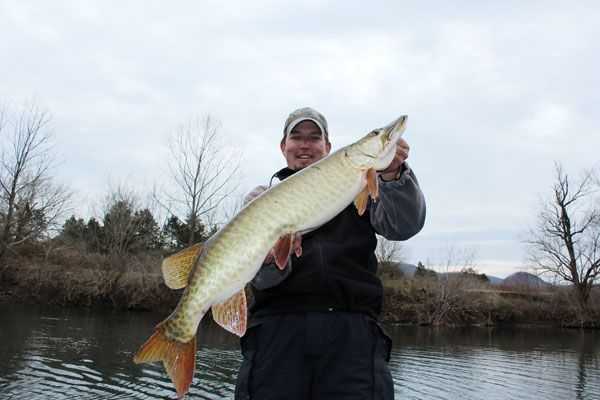
Musky Fishing Never Stops in the South
While musky fishing continues to gain popularity, northern states continue to garner the press for the top musky destinations and rightfully so. States such as Wisconsin and Minnesota are covered with great musky lakes and rivers. When fishing for muskies in the South, Cave Run in Kentucky is typically the “go-to” lake. Often overlooked in the mix are two flows in southwest Virginia, the New and James Rivers. With a growing population of musky, both rivers have been managed by the Virginia Department of Game and Inland Fisheries (VDGIF) for trophy fish for some time. The major advantage these two rivers and other musky waters of the South have over northern musky waters is that they can be fished the entire season. The winter, pre-spawn months of January, February, and early-March are the peak trophy season in the South when northern waters are typically frozen over and unfishable.
New River
The New River starts near Blowing Rock, NC and flows into Virginia and then turns northwesterly heading into West Virginia and eventually becoming the Kanawha where it meets the Gauley River. The New River is an ancient river dating back some 10 to 360 million years and is widely recognized as the second oldest river in the world. With an excellent stocking program coupled with successful spawns, the musky population in the New River continues to grow at a very fast pace making it the number one musky fishery in the state of Virginia. The state record musky, caught in June 2007, registered in at a whopping 45lbs, 8oz.
The New River is characterized by long, deep pools ridden with ledge structure from bank to bank. Many New River muskies come from the middle of the river because of the intense mid-river habitat. Throughout many sections of the New, deep bank cover in the form of lay downs and big chunk rock are also available and hold a good number of quality fish. Just like any other musky impoundment, understanding where these fish hold and feed is critical for angler success. Starting around January, and as the water changes from super clear in the early fall to a more greenish tint as it cools into the low 40’s/high 30’s, fish staged in winter holding locations become much more available before they move into more aggressive feeding locations, often nearby. Eddies with depth and that hold baitfish are often prime feeding locations and become better as you move into the months of February and early-March. Typically, these two months produce the heaviest fish as the biggest fish feed heavily before their spawning season starts. This happens as water temps reach near mid 40’s, which often occurs during the middle of March.

James River
The Cowpasture and Jackson Rivers meet near Clifton Forge, VA to form the James River which flows easterly towards Richmond and the Chesapeake Bay. The James flows 348 miles solely within the state of Virginia, the 12th longest flowing river in the United States beginning and ending in the same state. The James is smaller than the New River in size, and has less overall “musky water.” However, with excellent management from the VDGIF and a great forage base, it has thrived in recent years producing great numbers of quality fish.
The James is characterized by big, deep water bends typically with chunk rock banks on the outside bend and excellent lay down structure on the inside bend. James River fish can move a long distance between their winter and summer haunts, evidenced by angler reports of tagged fish traveling some 17 miles or more. In the cold weather months, James River fish follow the bait fish. Current breaks holding bait fish tend to lure aggressive, feeding muskies. As the spawn begins near mid-March, James River fish can become even more aggressive.
Both the James and New Rivers are excellent fisheries holding good numbers of trophy fish 40 inches or larger. The current creel limit in Virginia is two fish per day not less than 30 inches, except for the New River, which specifies one fish per day not less than 42 inches. The VDGIF offers trophy citations for fish 40 inches or bigger that are caught, measured, and released.

Muskie Fishing Tips
Like any other body of musky water, timing, in addition to understanding the fish (within reason), is critical for successful musky fishing. Winter baits of choice include deep diving crankbaits (Musky Train Loco Shad), jerkbaits (Esox Research Company DD), swimbaits (Adam’s Custom Lures Mega Trout), and glide baits (Esox Research Company Hellhound). Jet boats are a great option to fish these rivers in the early season when river levels are typically higher. If you want to avoid the crowd, a raft/fishing frame setup or dory-style drift boat are excellent options to explore less pressured waters. Floats typically range between 5 and 10 miles and there are numerous VDGIF boat ramps along both rivers. Please note that the New River below Claytor Dam is dam-controlled and Appalachian Electric Power generates, at will, hydro-power during the winter months.
[easy-social-share]